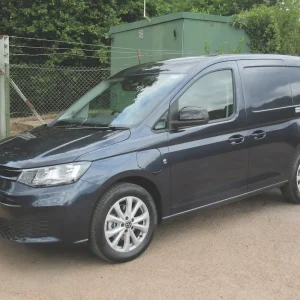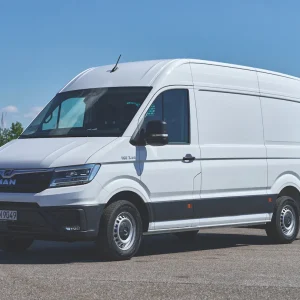Iveco is promising better economy, improved load carrying capabilities and superior handling and ride quality for its new Daily van and chassis cab line-up, which will arrive in UK showrooms in September.
Built in Suzarra, Italy and Valladolid, Spain for the European market, Iveco claims 80% of the bodyparts are new – including the completely redesigned wishbone Quadleaf front suspension on 3.5-tonne versions and recalibrated rear suspension, the components contributing most to an improvement in ride quality, according to product marketing boss Giuliano Giovannini. He says the developments have cut out oversteering when cornering to enable a more natural and instinctive driving behaviour.
The new system can also support 1.9 tonnes on the front axle, has raised ground clearance and is lighter than the previous arrangement – thus improving payload by 44kg. The new Daily retains the ladder frame chassis to which Iveco attributes its renowned sturdiness.
The manufacturer has invested Euro 500m in the third all-new generation of the van that first appeared in 1978 and then became the first LCV to use common rail diesel technology in 1999. The new Daily retains the 2.3 and 3.0 litre engines of its predecessors with power outputs ranging from 106, to 130 to 150 in the smaller powertrain up to 205hp in the flagship 3.0-litre. The manufacturer claims it has improved fuel efficiencies by 5.5% across the line-up.
Load spaces go from 7.0m3 to a cavernous and, Iveco claims, class-leading 19.6m3.
According to Iveco brand president, Lorenzo Sistino, almost 40% of customers will choose volume capacities of 9-11m3, 35% will opt for 11-14m3, one-in-five will choose load spaces of 14m3 or more while the smallest number (sub-10%) will require a cargo box of no more than 9m3. Sistino says Iveco is targeting the first of these categories as a its key growth area.
At the time of writing Iveco had not released UK pricing but promised list prices would be slightly lower than the current model in order to more realistically reflect actual transaction prices. UK product boss Martin Flach says this is a strategy already adopted by passenger car makers – with the reduced list prices resulting in more modest discounts.
As a rear-wheel-drive model in a sector that is predominantly made up of front-wheel-drive vans, Iveco is targeting the RWD Mercedes Sprinter as the direct competitor for its new Daily. Both brands claim RWD offers superior traction and durability over forward-driven alternatives but Iveco says its model will deliver better performance for less money (the current Daily range starts at just over £20,000 compared to almost £21,000 for the Sprinter).
We got the chance to put the new Daily through its paces in left-hand drive mode on the international launch in Balocco, Italy.
We chose the medium-wheelbase (3520mm), short overhang (1120mm as opposed to 1520mm on the 3520L), medium roof height (H2) version powered by the 2.3-litre 150hp engine. Isuzu has earmarked this as likely to be one of the best-selling “pivot models”. The brand says a longer wheelbase coupled with reduced overhang has made for better driveability.
The model has a payload of 1200kg and a load volume of 10.8m3 – up from 10.0m3 in the equivalent current model. The manufacturer has lowered the loading height by 55mm to 675mm by revising the rear suspension and fitted a footstep at 460mm off the ground to ease loading and unloading.
Iveco claims this version is best in class for cargo efficiency – an index that measures the ratio between the length of the load bay with the total vehicle length. Once behind the wheel, we were able to verify for ourselves the van’s impressively tight turning circle of 11.9m. Mercedes cites a turning circle of 12.6m for the MWB Sprinter. The shortest wheelbase Iveco van (3000mm) has a turning circle of just 10.5m.
The van we tested came with six-speed manual transmission but Isuzu says the semi-automatic Agile system favoured by key fleet customers – the supermarket giants Asda and Tesco – will also continue to be available in the new line-up.
Iveco says it encourages customers to specify their vehicles according to their particular requirements by selecting from a variety of option packs. Nevertheless, it is marketing the Daily in the UK with a choice of three trim levels, Daily, Daily Plus and Daily Top – the one installed in the model tested here.
This gets you features such as manual air conditioning and an air-suspended driver’s seat in addition to the likes of cruise control and electric mirrors that come with the specification below and are themselves extra to the base spec van equipment.
Air-suspended seats are an acquired taste, they occasionally seem to move independently to the rest of the vehicle, but we reckon choosing one for the Daily could help to take some of the strain out of a hard day’s multi-drop delivery work – especially on roads riven with speed humps and potholes.
With maximum torque of 350Nm the 150hp engine pulls strongly from standstill and offers a wide range in sixth gear from about 50mph even with the 900kg load we had in the back.
The gear shift is decent enough, if a little notchy and not quite up to the standard of those in the new Transit or Sprinter vans. The work on the suspension appears to have paid off though, with incisive handling when negotiating winding roads. We liked the new, smaller steering wheel too.
The Eco pack fitted to our van meant it got stop/start – but it should be noted that this is not an option with Agile transmission.
Pressing the Eco button on the dash reduces top speed to just over 70mph and cuts torque when not required. Iveco claims this can result in fuel savings of 13%.
The Daily comes with ESP as standard but Iveco has not loaded it up with extra safety features, such as Crosswind Assist, as Mercedes has with the Sprinter, claiming that developments such as the remodelled suspension and improved handling have made the van “intrinsically safer” anyway. It does, however, get a Lane Departure Warning System that emits an acoustic alert when the vehicle departs from the marked lane without the driver indicating. The system is designed to prevent accidents caused by drowsiness or distraction.
We were also impressed by the performance of the ABS braking system, which brought the vehicle smartly to a skid-free standstill in a test conducted on a wet road.
The cab at first feels a little cramped in terms of headroom, but this is the price paid for the useful shelf in the load bay for long items that extends above the passenger compartment. Inside you get a full-length overhead shelf and three lidded storage compartments on the top of the dashboard as well as three cup holders and big bins in the doors.
The driving position is good, although steering is adjustable only for rake, with ample visibility and everything is laid out within easy reach.
The middle seat folds down to reveal a desk top and an unusual feature is that the flat work surface is detachable to provide a laptop tray.
The passenger bench seats lift up to provide generous storage space for toolboxes, jackets and hard hats.
Verdict
Better handling and refinement coupled with improved load carrying capacity make the new Daily an even more viable contender in the large van sector.





